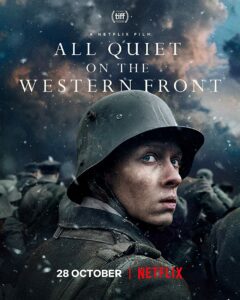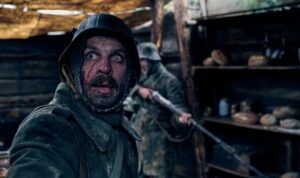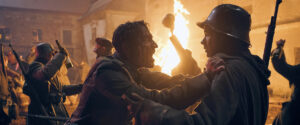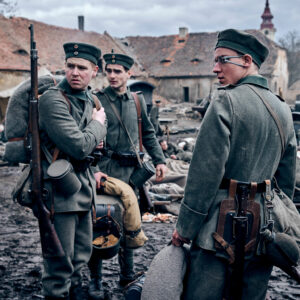Directed by Edward Berger | Written by Berger, Lesley Paterson, Ian Stokell, based on the novel by Erich Maria Remarque | 148 min | ▲▲▲▲△ | Netflix
I’m familiar with the 1930 original adaptation of the novel, which was released as a silent but also, later, in a sound version, and then the 1979 CBS TV version. Both are very much worth watching, and I’m glad to report this new version is as well — gorgeously shot, well acted, and entirely brutal. It’s technically not a remake but a fresh adaptation of the novel, a German-language version, and like the earlier films it’s a deeply convincing anti-war screed.
It starts in November 1917, in the silent forest with foxes and their kits — with a hopeful sense that nature continues despite the horror.
The First World War is already three years in. A group of German friends — Paul Bäumer (Felix Kammerer), Albert Kropp (Aaron Hilmer), Franz Müller (Moritz Klaus) and Ludwig Behm (Adrian Grünewald) — are keen to join up to fight for the fatherland. They’re given uniforms other young men had been killed wearing — they’re clueless about this, of course. To the front they go, singing their songs — connecting with veteran soldiers, Stanislaus “Kat” Katczinsky and Tjaden Stackfleet (Albrecht Schuch and Edin Hasanovic) — but find nothing there at all worth heroism, just mud, blood, and death. One by one, the friends meet terrible ends, all seen through the increasingly traumatized eyes of Paul.
As we move forward in time to November 1918, the last days and hours of the war, we also spend time with one Matthias Erzberger (Daniel Brühl) who’s negotiating for peace with the French, while a General Friedrichs (Devid Striesow) refuses to accept defeat.
The movie is up for Best Picture at the Oscars, and I can understand why. In broad strokes it’s excellent — all the departments deliver, from production design, sets, costumes, sound design, direction, cinematography, and performances. Loved the three-note apocalyptic theme by Volker Bertelmann.
I have to admit, though, at first I wasn’t immediately drawn to watch the film.
With 1917 just a couple years back and two other excellent versions of this story available, I wondered about the reasons for continuing to tell the same tale over and over again. Perhaps other stories set in the era of the Great War could come to light, maybe ones where women’s contribution and sacrifice feature more prominently than just sewing uniforms — and a woman even has a line in the movie. A fresh perspective is always welcome.
On the other hand, I can’t deny when the work is this good it justifies the effort. Not to mention the last adaptation of this particular story was made more than 40 years ago, and there’s never been a feature film version in German. In a way it’s been reclaimed with a film that can be considered definitive.
Having seen it now I understand. A whole new generation may learn a thing or two about what it was like in the trenches from this excellent edition, and we can’t have too many explicit reminders of war’s waste and stupidity.













